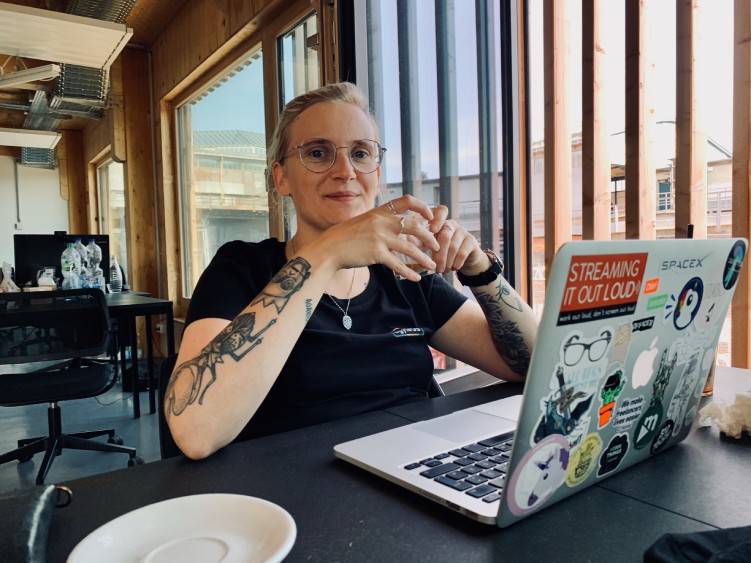Deep Dive #21: The human at the core with UUX from Berlin
Usability and user experience are increasingly perceived as success factors for companies. Buyers and users prefer products that are characterised by good UUX. Studies have shown that, in addition to price and technical criteria, such as functionality, reliability and performance, buyers and users increasingly select products for UUX aspects as well. However, there is often a lack of expertise or knowledge about the appropriate methods. Here, numerous service providers in the capital region can help.
Taking user needs as the basis for development
The trend towards agile methods and new-work approaches, instead of insisting on rigid processes, is not entirely new. Therefore, it is not surprising that, on the agyleOS saaS platform, a rigid structures turns out empty. This is intentional; after all, this is the first "Operating System for People, Agility & Culture". "The idea of agyleOS came out of our many years of working together", says Co-Founder & CPO Christin Löhr, "... the system emerged from many conversations with companies". Starting in 2013, at the Berlin-based video solutions provider "movingimage", she and her eight co-founders had been experimenting with the topics of agility and people empowerment. "Ultimately, we lacked an operating system that met our need for self-organisation and transparency", says the Berliner-by-choice, because "most systems on the market are either made for highly traditional processes or only for specific topics". She says that this is leading to the introduction of additional analogue and digital tools such as OKR (Objectives and Key Results) or 360° feedback, which is overwhelming everyone involved. "We want to enable a holistic view of the organisation", Löhr says. Instead of organisational charts, as found in hierarchically structured HR software systems, agyleOS focuses on an agile framework that maps and connects the different teams and areas. To simplify self-organisation, all participants can manage their skills themselves. agyleOS places special emphasis on integration of software tools such as surveys, or retro-action tools and KPIs to measure the maturity of agility. Christin Löhr knows as well that: "Our UX/UI designer Deniz has a background in infographics", she explains, "which makes him quite experienced in graphically presenting complex content in a simple and understandable way. The result is a highly intuitive usability".

"We started with the first beta customers at the beginning of the year and we went live in the summer with our MVP[ed. note: "minimum viable product"]", says Löhr, "We've since moved into operations and are onboarding a wide variety of organisations".These are mainly companies that offer or develop a software product and employ between 100 and 300 people. In general, however, the topic of agility affects virtually every industry and company size. Thanks to the high level of understanding of users and a strong focus on their needs, the Berlin-based startup has hit a nerve. Solution-oriented and user-oriented design is increasingly regarded as a success factor for products and services, if it is aimed at least at a high degree of usability and in the best case at a positive user experience (UX).
Achieving effective results with simple UX measures
"UX design is less about how a product looks and more about how it works," explains Kai Wermer, managing director of the Berlin agency Uhura, which has been supporting UX design processes for clients such as Uniper Engineering or the heating oil company Total for more than 20 years. UX design is about truly understanding the habits, needs, behaviours, motivations and emotions of the users. Without this exploratory research component of the process, UX design becomes "normal" web design. It would be a lost opportunity, since "even simple UX measures can achieve dramatically better effects, "Wermer says. "A little A/B testing for a feature like a newsletter subscription or a shopping cart, and a rewrite of the content and UI elements by an experienced UX writing can produce such improvements". He speaks from experience, as the service and ordering processes for distribution partners have been repeatedly optimised on the Total Heating Oil Platform in A/B tests, for example. With success, as the growing conversion rates show.

Including UI/UX in one’s sights
At agyleOS, Christin Löhr and her colleagues are also focusing on constantly improving the UX to make the platform accessible to different target groups. "Part of our mission with our platform is to not only make diversity visible in companies, but also to promote it, because we strongly believe that better results are achieved through different perspectives in diverse teams", says Löhr, "so of course we are also committed to delivering inclusive UI/UX that takes user diversity into account". One example of this is the pronunciation feature, where users can record and save an audio file in their profile to help other users pronounce their name correctly.In order to test features quickly and redesign them if usability is not satisfactory, the team, which now has 12 members, works closely with the Technical University of Berlin in seminars.
However, proximity to the university was not the only reason why agyleOS did not consider any other location for the nine former colleagues. "Initially, we got to know each other here as a team of founders, so Berlin was our common hub from the very beginning", explains Löhr, "but of course there's also the fact that Berlin is still the location in Germany, if not in Europe, for startups in the software sector". There's also a lot going on in the German capital when it comes to usability & user experience (UUX).
In addition to the Technical University of Berlin, institutions such as Vision and Imaging Technologies / Fraunhofer Heinrich Hertz Institute, School of Design Thinking / Hasso Plattner Institute, Creative Computing / HTW and Artop / Humboldt University Berlin are also involved. In addition, there are research groups such as the Design Research Lab, which was established in 2005 at Deutsche Telekom Laboratories and at the Technical University. Since the time, five years later, that the 20-member interdisciplinary team moved to the Berlin University of the Arts, Faculty of Design, the DRL has been working on approaches such as new tactile forms of interaction with end devices ("embodied interaction") and textiles ("interwoven technologies"). The lively UUX scene in Berlin is also reflected in the multitude of smaller to larger networks, groups and platforms such as Hybrid Platform, Ladies that UX Berlin and International Design Centre.
From UX Design Awards to World Usability Day
The International Design Centre can rightly be considered one of the pioneer networks in the field of UUX. Founded in 1967, the independent design institution, with its multidisciplinary network of members, links the design sector with companies and promotes the exchange of knowledge. In promoting this interaction, events play a central role. From such an event, namely the 2008 Exhibition for Good Usability, the international UX Design Awards emerged seven years later. Excellent solutions for innovative experience design from all over the world will be honoured and awarded in Berlin. The prestigious awards are not the only event in the UUX scene that have selected the German capital as their venue. A large number of conferences and events take place in Berlin every year. For World Usability Day (WUD) on 11 November 2021, the German capital joined the ranks of 200 events in over 40 countries around the world, facilitating a broad exchange on the topic of "Designing Our Online World: Trust, Ethics and Integrity".

One of the participating organisations at the WUD in Berlin is the Mittelstand 4.0-Kompetenzzentrum Usability. Throughout Germany, the association supports small and medium-sized enterprises in recognising and implementing the potential of UUX. This is because: "The better the UUX, the faster the digital transformation of small and medium-sized enterprises", the website says. In addition to events, brochures and other information measures, the Competence Centre focuses primarily on the implementation of pilot projects. "In our experience, most startups and SMEs already have a base of knowledge", says Prof. Dr. Markus Feufel from the Technical University of Berlin, who is the contact person for the region. This can be supplemented, refined and tested in the method workshops or free pilot projects. Feufel tells us what such pilot projects can look like in concrete terms, using an example from 2019: At the time, the organisation known as the "Climate Rebels" wanted to show people ways in which they could offset their carbon footprint when buying products. In order to get to know the potential users, the pilot project group conducted a needs analysis based on approximately 1,400 participants. Next, a focus group created a detailed list of requirements for the functionalities of climate-neutral products and services. Then, a customer journey based on the example of "flying" was to show the information presentation of the CO2 compensation for users at individual touchpoints. Often, companies do not lack the necessary know-how. Rather, according to Prof. Dr. Markus Feufel, one of the biggest challenges is "the lack of understanding among clients that software that is easy to use is somewhat more expensive than software that is not tailored to users" . "UUX measures are often considered nice-to-have when it comes to concrete implementation in products", he continues. In addition, the high turnover of employees, particularly in startups and small companies, means that knowledge is easily lost.
Diverse UUX environment with increasing demand
These are challenges that do little to diminish the growing importance of the UUX sector in the federal capital. According to Feufel, as early as 2016, a market research project identified 34 companies that acted as UUX agencies or service providers. "Since then, some of the companies - such as UseTree, Userlutions or Human Factors Consult - have grown strongly", says the expert, "with the addition of many freelancers".In addition, well-known German service providers such as Ergosign and UiD have also opened offices in Berlin. "These companies rely in part out-of-region work because local demand are not sufficient", Feufel says. "The environment in Berlin is diverse and, with its many smaller companies and freelancers, is satisfying the varied needs of regional and national companies".
In particular, people with work experience in the UUX field are more in demand than ever, he said. "As such, training programmes such as the master's degree programme in Human Factors at the Technical University of Berlin are attempting to provide initial experience for future UUX professionals as early as the training stage, via practical seminars and projects with companies", says the TU professor, adding: "In our view, there are no industry-specific differences to be seen. The need is high everywhere".
In the Deep Dive series, Projekt Zukunft gives regular insights into current technologies in the digital, media and creative sectors and provides information about actors, trends and applications from Berlin.
Contact
Tanja Mühlhans
Leitung Kreativ- und Medienwirtschaft, Digitalwirtschaft, Projekt Zukunft


